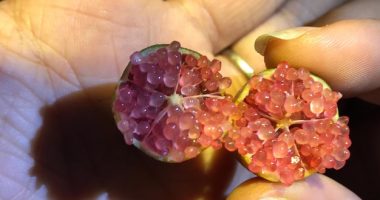Researchers have made a groundbreaking advancement in the genetic modification of wheat that promises to transform agricultural practices. In a significant study led by Barbora Ndreca, Alison Huttly, and their team, a new approach to creating semi-dwarf wheat varieties, which are shorter and more resistant to adverse weather conditions, has been developed. Traditionally, semi-dwarf varieties in cereals like rice and barley have utilized alleles affecting the gibberellin biosynthesis pathway, specifically through the enzyme GA20OX2. However, this method posed challenges in wheat due to its complex hexaploid genome, which consists of three homoeologous copies of GA20OX2, making typical loss-of-function mutations less effective due to functional redundancy.
In a novel approach detailed in their study titled “Stacked mutations in wheat homologues of rice SEMI-DWARF1 confer a novel semi-dwarf phenotype,” the researchers employed reverse genetics to target and mutate all three homoeologous copies of GA20OX2 along with its paralogue GA20OX1. Their field trials over three years showed that these mutations produced a significant reduction in plant height, by 12-32%, without negatively impacting yield components in the tested spring wheat variety ‘Cadenza’. This research not only illustrates the efficacy of chemically induced mutagenesis in exploiting genetic variation but also lays the groundwork for further exploration of these novel alleles to enhance the robustness and productivity of wheat varieties across varying environments and genetic backgrounds.
The cultivation of wheat, one of the most widely consumed grains globally, has been continually influenced by genetic advancements aimed at enhancing yield, resilience, and adaptability. The journey towards modifying wheat to better suit the needs of a growing population under varying climatic conditions has been complex, especially given the challenges posed by its intricate genomic structure. Unlike simpler diploid crops, wheat is predominantly hexaploid, comprising three sets of homologous chromosomes, which adds layers of complexity to genetic manipulation efforts.
The historical context of this research traces back to the mid-20th century with the Green Revolution, which saw the introduction of semi-dwarf varieties in key staple crops like rice and wheat. These shorter, sturdier plants were less likely to fall over (lodge) under the weight of grain, particularly in adverse weather, thus significantly improving yield reliability. The semi-dwarf trait in these crops was primarily introduced through mutations in genes affecting gibberellin biosynthesis, a critical plant hormone pathway involving the enzyme GA20OX2, among others. In rice, the famed semi-dwarf variety IR8, which transformed rice farming in Asia, was developed through such genetic modifications.
However, replicating this success in wheat has been challenging due to its genetic complexity. Wheat’s hexaploid nature means that each gene typically exists in three versions (homoeoalleles), one from each of the three ancestral sub-genomes. Traditional methods, which might effectively target a single gene in a diploid organism, are less straightforward in hexaploid wheat because mutations must be introduced in all three corresponding genes to achieve the desired phenotype. This redundancy often dilutes the effect of a mutation in any single gene, requiring a more comprehensive strategy for genetic alteration.
The groundbreaking work by Ndreca, Huttly, and their team represents a pivotal shift in the approach to genetically modifying wheat. By employing a sophisticated technique that involves targeting and mutating all three homoeologous copies of GA20OX2, as well as its paralogue GA20OX1, the researchers were able to overcome the genetic redundancy that has historically complicated wheat modification. The success of these stacked mutations in creating robust, shorter plants capable of maintaining high yield under varied conditions is a testament to the potential of this novel approach.
Their research builds upon decades of agricultural and genetic science, leveraging both the lessons of past breeding successes and the latest techniques in genetic engineering. The significance of this breakthrough cannot be overstated, as it not only enhances current wheat varieties but also provides a valuable template for future crop improvement efforts across other cereals with complex genomes. This blend of traditional breeding techniques with cutting-edge genetic manipulation opens new avenues for ensuring food security in the face of climate change and a burgeoning global population. Such advancements are crucial in the ongoing quest to optimize agricultural productivity while minimizing environmental impact.
The methodology employed in the research by Barbora Ndreca, Alison Huttly, and their team was methodologically to address the complexities inherent in wheat’s hexaploid genome. They adopted a sophisticated reverse genetic approach that involved targeting and mutating the specific gene alleles GA20OX2 and its paralog GA20OX1 across all three of the wheat genome’s homoeologous sub-genomes (A, B, and D). This strategy was integral in overcoming the functional redundancy that typically prevents effective genetic manipulation in hexaploid wheat.
1. **Gene Targeting and Mutagenesis**:
The team used chemically induced mutagenesis, specifically employing ethyl methanesulfonate (EMS), which is known for its effectiveness in inducing point mutations in DNA. This chemical agent was used to treat the seeds of the wheat variety ‘Cadenza’, following established protocols that ensure effective mutagenesis while maintaining germination viability. The mutated plants were then grown, and their DNA extracted and sequenced to identify mutations in the target genes.
2. **Selection of Mutants**:
Sequence analysis was conducted to detect mutations that led to the truncation or significant alteration of the GA20OX2 and GA20OX1 proteins. Each identified mutant allele was cataloged and assessed for its potential impact on the enzyme’s function, focusing on those likely to result in a reduced activity of gibberellin biosynthesis. The researchers used a combination of PCR screening and sequencing to ensure precise identification of mutations across the three homoeologs.
3. **Stacked Mutants**:
Combining multiple mutations within a single plant line was crucial for this study. Through traditional cross-breeding and backcrossing techniques, plants that possessed mutations in all three homoeologous copies of GA20OX2, as well as mutations in GA20OX1, were produced. This ‘stacking’ of mutations is a novel approach in wheat and was hypothesized to result in a more pronounced semi-dwarf phenotype due to synergistic reduction in gibberellin biosynthesis.
4. **Field Trials**:
Over three years, field trials were conducted to evaluate the agronomic performance of the mutant lines. The trials were set up in a randomized block design to statistically validate the findings. Parameters such as plant height, tiller number, grain size, and yield components were meticulously recorded under various environmental conditions. This extensive testing was critical to determine the stability of the semi-dwarf trait and its effects on yield and other agronomic traits.
5. **Data Analysis**:
Statistical analysis of the field data helped in quantifying the impact of the stacked mutations. Advanced statistical tools and software were used to analyze the variance in traits between the mutant and control lines, allowing the researchers to draw significant conclusions about the efficacy of their genetic manipulations.
This comprehensive methodological approach not only demonstrated the successful application of chemically induced mutagenesis and gene stacking in wheat but also set a benchmark for future genetic studies in complex genomes. The resultant semi-dwarf wheat varieties emphasized how precise genetic manipulations could lead to desired phytotypic outcomes that are stable across various environmental conditions, thereby paving the way for more robust and resilient agricultural practices.
The key findings from the comprehensive study led by Barbora Ndreca and Alison Huttly reveal promising outcomes that could have substantial implications for future wheat cultivation. The research team successfully developed semi-dwarf mutant lines of the wheat variety ‘Cadenza’ that demonstrated a substantial decrease in plant height without compromising yield components, a critical aspect in agricultural practices aimed at sustainability and efficiency.
1. **Reduction in Plant Height**: One of the most significant findings from the field trials was the consistent reduction in plant height across the mutant lines. The mutants displayed a height reduction ranging from 12 to 32% compared to the control plants. This semi-dwarf stature is particularly advantageous as it reduces the risk of lodging – where plants fall over under the weight of heavy grain, particularly under adverse weather conditions like strong winds or heavy rains. Such robustness in plant structure ensures that the plants are better capable of surviving and thriving under varying environmental pressures, thereby making the wheat crop more reliable across different seasons and geographical areas.
2. **Maintained Yield Components**: Importantly, the reduction in plant height did not adversely affect the yield components of the wheat. This includes factors like the number of grains per ear, grain size, and overall grain yield. The grain yields of the mutant lines were comparable to those of traditional ‘Cadenza’ plants, indicating that the mutations did not compromise the plant’s productivity. This finding is crucial as it confirms that agricultural efficiency does not have to be sacrificed for resilience and adaptability.
3. **Genetic Stability Across Environments**: The mutant lines were tested across different environmental conditions over three successive years, demonstrating that the traits were stable regardless of varying climatic conditions. This stability is vital for the practical application of these genetic modifications in real-world agricultural settings, where environmental variability is the norm.
4. **Potential for Further Genetic Improvements**: The success of the stacked mutations opens up new avenues for further enhancing wheat varieties. Because the semi-dwarf phenotype is achieved without negatively impacting yield, researchers can now explore additional genetic modifications that might increase resistance to pests, diseases, or further improve yield under stress conditions such as drought or extreme temperatures.
5. **Implications for Other Cereals with Complex Genomes**: Perhaps one of the wider implications of this study is its potential applicability to other cereals with similarly complex genomes, such as oats and barley. The methodologies and successes documented in this research could serve as a template for addressing genetic challenges in other important crops, potentially revolutionizing agricultural practices more broadly.
In conclusion, the research meticulously conducted by Ndreca, Huttly, and their colleagues not only challenges and advances our understanding of genetic manipulation in hexaploid wheat but also provides a blueprint for future work in crop genetic improvement. By demonstrating that significant phenotypic changes like reduced plant height can be achieved without detrimental effects on yield, this study reaffirms the potential of genetic advancements to meet global food supply challenges head-on while adhering to sustainability principles. The continuation of this line of research could very well dictate the direction of future crop development strategies, aligning them with the needs of a growing global population and the complexities of climate change.
The exciting breakthrough in wheat genetics spearheaded by Barbora Ndreca, Alison Huttly, and their team not only showcases the power of modern genetic manipulation but also sets the stage for transformative changes in global agricultural practices, particularly in the cultivation of cereals with complex genomes. The success of their approach—utilizing stacked mutations to create stable, resilient semi-dwarf wheat—opens up numerous pathways for future research and development that could greatly influence food security and sustainability.
Looking forward, several avenues seem particularly promising. Firstly, the technique of stacking mutations could be extended to other traits critical to agricultural success, such as drought resistance, nutrient use efficiency, and resistance to pests and diseases. By combining multiple beneficial traits into single wheat varieties, it might be possible to develop “super crops” that not only yield more consistently but also use fewer resources, a crucial advantage in regions facing climate variability and resource scarcity.
Moreover, the methodology employed by Ndreca, Huttly, and their team could be adapted for other major cereal crops like maize, barley, and oats, where genetic complexity also poses significant challenges for breeders. The lessons learned from the wheat experiments could accelerate genetic improvements across a broad spectrum of crops, enhancing global food systems’ resilience.
Another promising direction could involve the integration of these classical breeding techniques with emerging technologies such as CRISPR/Cas genome editing. While the research detailed involves chemically induced mutagenesis, the precision and efficiency of CRISPR/Cas could streamline the creation of targeted mutations, potentially speeding up the breeding process and allowing for even more nuanced manipulations of the plant genome.
Furthermore, as data collection and analysis become increasingly sophisticated, leveraging big data and machine learning could provide deeper insights into complex trait development and environmental interactions. This technological integration could lead to more predictive and efficient breeding programs, reducing the time and cost associated with developing new crop varieties.
As these scientific and technological advancements continue, it is also crucial to address the regulatory, ethical, and social implications of advanced genetic modifications in agriculture. Transparent discussions involving scientists, policy-makers, and the public are essential to navigate the concerns related to GMO crops and ensure that the benefits of such technologies are realized safely and equitably.
In conclusion, the study by Ndreca, Huttly, and their colleagues not only marks a significant milestone in the field of plant genetics but also serves as a foundational platform for future innovations in crop science. By continuing to build upon this groundbreaking work, the global agricultural community can look forward to developing crop varieties that are not only high-yielding and environmentally resilient but also tailored to meet the diverse needs and challenges of the 21st century. The journey from lab to field, and eventually to our tables, promises exciting possibilities for feeding the world’s growing population in a sustainable and efficient manner.









